Tokarev self-loading rifle
By the end of the 30s, designers in different countries had been working on the creation of self-loading (automatic) rifles for about four decades. This time is marked by significant changes in the development, production and use of automatic small arms. The machine guns have come a long way in development, at least one generation of light machine guns has been replaced, and they have appeared and taken their place in the weapon system aviation, tank, heavy machine guns, submachine guns. Meanwhile, work on automatic rifles still did not lead to the appearance of a mass sample.
Samples that were put into service, were produced in small quantities and were used very limited. The reasons for such modest success in the 30-s were pointed out by such major gunsmiths as V. G. Fedorov and A. A. Blagonravov. This is a contradiction between the presence of an automation system and weight restrictions, and excessive power and weight of rifle cartridges, and a reduction in the role of rifle fire at medium and long ranges in the development of light machine guns. But the idea of an automatic rifle as the main and most mass weapon continued to occupy the minds of the military, although it changed with the overall development of weapons.
The advantages of an automatic or self-loading rifle in front of a magazine rifle were obvious - an increase in the combat rate of fire and the likelihood of hitting small moving targets appearing for a short time, saving the shooter’s forces, the possibility of firing in movement and making several shots in a row from any position (for example, lying down when operating with the shutter handle is uncomfortable). And the desire to maintain the range of aimed shooting and fears before moving to a new cartridge made it necessary to hold relatively powerful rifle cartridges.
HISTORY OF CREATION
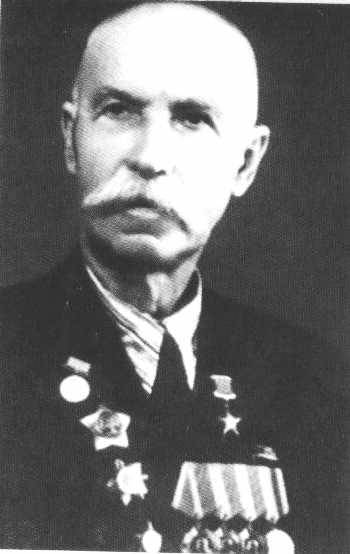 In Russia, work on the automatic rifle began in the 1907 year. Among the most active participants in the development was Cossack officer Fedor Vasilyevich Tokarev (1871-1968). His rifle with automatic recoil-based barrel with a short stroke was selected in 1914 for military tests along with samples of VG Fedorov and J.M. Browning.
In Russia, work on the automatic rifle began in the 1907 year. Among the most active participants in the development was Cossack officer Fedor Vasilyevich Tokarev (1871-1968). His rifle with automatic recoil-based barrel with a short stroke was selected in 1914 for military tests along with samples of VG Fedorov and J.M. Browning.The First World War interrupted these works, but did not close the topic. In the USSR, they officially resumed in the middle of the 20's. The Report of the Revolutionary Military Council of the USSR dated December 1929 stated: "The adopted infantry system of the Red Army provides for the introduction in the near future of a semi-automatic self-loading rifle."
In 1930, the Artillery Directorate determined that the rifle should have a fixed barrel, and the designers focused on the gas engine automation systems. In the same year, we note, adopted a modernized magazine rifle arr. 1891 / 30 and once again extended the military career of the 7,62-mm rifle cartridge. Already in 1931, the rifle of V. A. Degtyarev was prepared for troop testing, but although it received the designation “rifle mod. 1930 g. ", Bring it to the series failed, as the automatic rifle Simonov arr. 1931
In 1932, FV Tokarev began work on his new system. A small series was released his self-loading carbine arr. 1935, but officially adopted an automatic rifle Simonov arr. 1936 (ABC). True, the main for the ABC was considered fire single shots - operating experience proved that with a light barrel, a small mass of weapons and a powerful cartridge, the accuracy of automatic firing was unimportant, the barrel quickly overheated and the ballistic characteristics of the rifle decreased.
22 May 1938, on the orders of the People's Commissars of Defense and Defense Industry, announced a new competition for a semi-automatic rifle. Samples of the system of S. G. Simonov, N. V. Rukavishnikova and F. V. Tokarev were presented, but Simonov and Tokarev became the main competitors. Tokarev's assistants in the work on the rifle were the design engineer N. F. Vasilyev, the senior master A. V. Kalinin, the designer-designer M. V. Churochkin, as well as the mechanics N. V. Kostromin and A. D. Tikhonov, the mechanic collector M. M. Promyshlyaev.
The tests ended in September 1938. At the conclusion of the commission, no sample met the requirements. Repeated tests already conducted on November 20 of the year 1938. The question was considered one of the most important. V.N. Novikov (on the eve of the Great Patriotic War — the chief engineer and director of the Izhevsk Machine-Building Plant, during the war — Deputy Commissar of Armaments) wrote in his memoirs: “Stalin personally followed the course of designing and manufacturing prototypes. It rarely happened that the defense meeting did not talk about a self-loading rifle. ”
26 February 1939, the Red Army adopted an 7,62-mm self-loading rifle of the Tokarev system arr. 1938 (SVT-38).
PRODUCTION AND IMPROVEMENT
But the issue has not yet been resolved completely. A special commission of the People’s Commissariat of Weapons and the Main Artillery Directorate, comparing the modified Tokarev and Simonov rifles, gave preference to the latter — in terms of weight, simplicity of the device, time and cost of production, and metal intensity. Simonov's rifle was also defended by the people's commissar of weapons B. L. Vannikov. But the decision of the Committee of Defense at SNK of the USSR from 17 July 1939 of the year stopped the further discussion. It was necessary to focus on mass production.
At the Tula Arms Plant (TOZ), the assembly of rifles in small batches began on July 25 from July 1939, and the gross release from October October 1. The assembly was organized on a conveyor belt with a forced rhythm - this was part of the introduction of mass production technologies into arms, although the manufacture of rifle parts still required a lot of mechanical processing.
The combat experience was not long in coming - the SVT went to the front already during the Soviet-Finnish war. Naturally, the new weapon required a number of improvements. Revealed a high sensitivity to pollution, dust and grease due to the relatively accurate, with small gaps fit parts.
Even before the end of the Finnish campaign, by order of Stalin, a commission was created under the chairmanship of the secretary of the Central Committee G. M. Malenkov to decide on improving the SVT with the aim of “bringing the Tokarev self-loading rifle closer to the Simonov self-loading rifle” - changing the production of one rifle with the threat would be risky.
The upgraded rifle was distinguished by a reduced weight on 0,3 kg, a new metal casing of the barrel lining, the appearance of a metal casing on the forearm. The ramrod was moved under the barrel, the bayonet was shortened (according to Vannikov, Stalin, having received feedback from the Finnish front, personally ordered “take the smallest, for example the Austrian,”).
In general, the scheme remains the same: automation based on the removal of powder gases through a transverse opening in the chamber above the barrel, equipped with a gas regulator, with a short stroke of the gas piston, muzzle brake, locking the barrel biased by a shutter in a vertical plane, trigger mechanism trigger a type that allows only single fire, a flag non-automatic fuse, a trigger with a “warning”, a solid wooden box with a pistol projection of the neck. The detachable box-shaped double-row magazine could be fitted out of the clip inserted into the grooves of the receiver. Sector sight is notched to 1500 m, that is, they went to a formal reduction of the target range compared with a rifle mod. 1891 / 30
13 April 1940, the decree of the Committee of Defense adopts the 7,62-mm self-loading rifle of the Tokarev system arr. 1940 (SVT-40).
The sniper version of the SVT was distinguished by a more careful trimming of the barrel bore and a tide of the receiver for mounting the bracket with a PU 3,5-multiple-view scope. Fastening the sight was done so that it was not hit by a spent cartridges, flying out of the window of the receiver. The mass of SVT with a PU sight is 4,5 kg.
The main manufacturer of SVT has become TOZ (Plant No. 314). According to the report of the People's Commissar of Weapons from October 22 1940, the Committee of Defense started the serial production of SVT-40 from July 1 1940. Izhevsk Machine-Building Plant (Plant No. 74) began production of SVT-40, using the capacities released after the removal of ABC-36 from production.
Mastering a new product always requires time and money: new machines are needed, restructuring of tool management, personnel retraining. As a result, 1941 1 800 rifles entered 000 1939 1 approved by SNK USSR and the Central Committee of the CPSU (b) for orders of armament for 100, of which self-loading made 000 XNUMX XNUMX, the rest are three-line stores.
WAR INTRODUCED CORRECTIVES
The almost catastrophic development of the events of the initial period of the war significantly aggravated the factors so common to such a situation as the sharp increase in tasks for the production of weapons, the disruption of production ties, the decline in the average qualifications of workers, and the accelerated wear of equipment. The weapons placed in front of the German aggression in the warehouses of the western military districts were lost. On 22 June 1941, the 7 720 000 rifles and carbines of all systems were counted in the army. In June - December, the losses amounted to 5 547 500, and only 1 567 141 was manufactured.
Increased production and complicated evacuation TOZ. By January 1 1942-th Red Army had around 3 760 000 rifles and carbines. The losses of the personnel of the Red Army in the first half of the Great Patriotic War are still arguing. But in any case, it was no longer a question of replenishment, but in fact of the urgent formation and arming of a new army. And if we talk about the shortcomings of the SVT, then the main at that time should recognize the combat characteristics, and production and operational.
The available capacity, reserves and mobilization reserves had to rely on a greater number of copies with less metal and machine-hours, reducing the requirements for finishing. The Trilinek was cheaper in production at 2,5 and much easier. The refusal to expand the output of the SVT in favor of the long-mastered magazine rifle and relatively simple to manufacture and mastering submachine guns essentially saved the day.
At the same time, the production of SVT was not stopped, but they abandoned its role as the main armament. In the 1941 1 year of the planned 176 000 «normal» and 37 500 40 sniper SVT-were manufactured respectively 1 031 861 and 34 782.
From Tula, the production of SVT was evacuated to the Urals, to Mednogorsk, where during the first month they managed to assemble 7000 rifles from the removed stock (the assembly from finished parts was already carried out during the evacuation - in trains, in specially equipped cars), so the break from production cessation in Tula before the start in Mednogorsk amounted to just 38 days.
In January, the 1942 of the year, the issue of SVT was practically returned to the former “Tula” level. But while in Mednogorsk they fought to bring the manufacture of Tokarev rifles to 50 thousands per month, the Izhevsk plant had already been assigned to give the army up to 12 thousands of magazine rifles per day. The plan for 1942 for the year already provided for the delivery of troops only 309 000 “normal” and 13 000 sniper SVT, and 264 148 and 14 210 were released. For comparison: magazine rifles and carbines for 1941 year produced 1 292 475, and for 1942-th - 3 714 191. SVT production was declining rapidly.
FEMALE CHARACTER
Often weapons samples are obtained in the army various unofficial nicknames. SWT, for example, was nicknamed "Light" - obviously, not only because of consonance. She attributed the capricious female character. The complaints received from the troops were mainly due to the complexity of the system itself, both in training, and in circulation, and in care. There were also complaints about a large number of small parts, due to the loss of which about 31% rifles were out of order, while the magazine rifle had a sample. 1891 / 30, this indicator was much lower - just 0,6%. Initially set rigid limits on the mass forced to perform many parts of SVT at the limit of strength and survivability. Apparently, this caused the tendency of the receiver to deform and, accordingly, the often mentioned insufficient strength of the locking assembly.
Some aspects of working with the SVT really proved to be difficult for mass weapons - for example, a rearrangement of the gas regulator was impossible without a key. When handling SVT, both more thorough care and an understanding of the basics of work were needed to quickly eliminate delays. That is, the soldier needed some technical training.
Coming to the rifle parts of the replenishment could not exploit such weapons. God forbid to blame the Red Army in this. The simple fact is that those who were familiar with the equipment before the service were selected as machine-gunners, tank and mechanized troops, artillery, etc., and mainly rural guys were recruited into the infantry.
Characteristically, the order of the People’s Commissariat of Defense, signed by Deputy Commissar for Army Commissioner 1 of the rank of E. A. Schadenko from October 3 of 1942, said: “The test performed ... showed that the training and spare parts basically coped with their task and they began to give the front a better prepared marching replenishment ... "But at the same time it was emphasized:" Rifle training, especially marching companies, is extremely insufficient. Fighters poorly know their weapons. ”
Parts of the army had very little time for training replenishment. So again, the trilinek turned out to be preferable. But at the same time, the marines and infantry brigades retained their “loyalty” to the SVT — the more technically competent guys were traditionally selected for the fleet. It worked reliably SVT in the hands of skilled snipers. Not badly trained special purpose groups of the NKVD and the GRU preferred to take SVT into the enemy rear.
FOR CHANGE - AUTOMATIC
The sniper SVT was the first to be removed from production - from October 1 1942. Self-loading rifle really inferior shop sniper on accuracy and accuracy of fire. However, in the same year, the automatic version of the Tokarev rifle appeared somewhat unexpectedly.
It would seem that even on the eve of the war, the poor accuracy of firing with bursts of rifles with a light barrel and the insufficient strength of the SVT receiver were well known. But again the urgent need intervened. At the beginning of 1942, there was a critical situation with machine gun weapons. March 18 1942 th head GAU N. Yakovlev reported to the State Defense Committee: "The situation with light and heavy machine guns threatens the breakdown of the formation of new military units, as well as the reimbursement of retired machine guns."
The episode testifies how urgent the need for troops in light automatic weapons was. The same Yakovlev recalled a certain craftsman on the Western Front, who in the fall of 1941 had converted the SVT into an automatic rifle. Stalin then ordered "the author to be rewarded for a good offer, and to punish him with a few days of arrest for unauthorized alteration of weapons." But the Commissariat of Armament already had documentation on the AVT, developed even before the war (the front-line craftsmen, of course, did not know about this). And on May 20, 1942 of the year, the decision of the State Defense Committee of the USSR to launch the production of AVT-40 came out - in July they went into the army.
AVT became a temporary measure, designed to increase the density of fire at 200-500 m distances during decisive minutes of battle. However, of course, they could not replace light machine guns with automatic rifles, and the production of AVT did not last long. By accuracy of shooting at a distance of 200 m, it was inferior to, say, a PPSh submachine gun. This is not surprising - if in the PPSH the ratio of the muzzle energy of the bullet to the mass of the weapon was about 172 J / kg, then for AVT and SVT - 787 J / kg. It is clear where recoil more influenced accuracy.
The problem of increasing the density of small arms during the war had to be solved at the expense of first of all submachine guns. Let's compare: during the years of the Great Patriotic War in the USSR, 12 139 300 magazine rifles and carbines and 6 173 900 submachine guns were released, and more than 40NNXXNXXXXXXXXXXXXXXXXXXXXXXXXXXXXXXXXXXNXXNNXXNNX 1940 1944 1 700. Only the 000 of January 60 of the year was completely discontinued to be released. By the beginning of the 000, weapons were already sufficient.
With the adoption of 7,62-mm intermediate cartridge arr. 1943, the issue of mass automatic weapons chambered for rifle power was actually removed. The machine gun under the intermediate cartridge became the main weapon of the infantryman. Already in April, the 1944 years passed the tests of V. A. Degtyarev, F. V. Tokarev, A. I. Sudaeva, S. A. Korovin automata. Note that in the design of the experimental Tokarev automatic machine, the features of the AVT-40 appeared, but he was one of the first to leave the competition. There was still a question about a self-loading sniper rifle, but it was solved in more than a decade and a half and on a new basis.
Interesting attitude to the SVT from the enemy. An attempt by German gunsmiths to bring the G.41 (W) "Walter" and G.41 (M) "Mauser" self-loading rifles to the series ended in failure. And the German army fairly widely used the SVT captured at the beginning of the war, assigning them the designation Sl Gew 259 (r) (for snipers, Sl Gew Zf 260 (r)).
In general, there is nothing special: lacking automatic weapons, the Germans widely used captured samples. However, the recommendation of counterguerrilla jagdos, for example, be sure to have a “Russian self-loading rifle with a telescopic sight” sounds quite eloquently. The captured SWT German soldiers and officers very willingly continued to use (when, of course, they had the opportunity to stock up on them with ammunition) even after the appearance of their own 7,92-mm self-loading rifle G.43 in the middle of the war (349 300 "linear "And 53 435 sniper). By the way, although G.43 was an independent system, it is possible to see the influence of the Soviet SVT in it — the arrangement of the flue gas assembly, a short piston stroke, a detachable magazine.
So, the reason for the curtailment of the production of SVT and the sharp drop in its role in the weapon system was not so much the design flaws as the problems of increasing production in harsh military conditions and the difficulty of operating hastily trained fighters. Had it been accepted on the eve of the Great Patriotic War, another sample, for example, a Simonov rifle, would certainly have suffered the same fate. The experience of the war forced to speed up work on a new cartridge and a new type of weapon (automatic), to change the approaches to the design and technology of weapon production.
After the Great Patriotic War in the USSR, the SVT remained in service with the honor guard of the Kremlin regiment (curiously, that it was later replaced by the SKS carbine of the Simonov system), passed on to hunters who, by the way, took it quite positively.
TACTICAL AND TECHNICAL CHARACTERISTICS OF THE RIFLE ARR. 1940 (SVT-40) Cartridge 7,62x54R (sample 1908)
Weight of weapon with bayonet without cartridges, kg 4,3
Weight of weapon without bayonet and cartridges, kg 3,85
The length of the weapon with a bayonet, mm 1465
Weapon length without bayonet, mm 1226
Barrel length, mm 630
Initial bullet speed, m / s 840
Sighting range, m 1500
Combat rate of fire, rds / min 25
Magazine capacity, cartridges 10
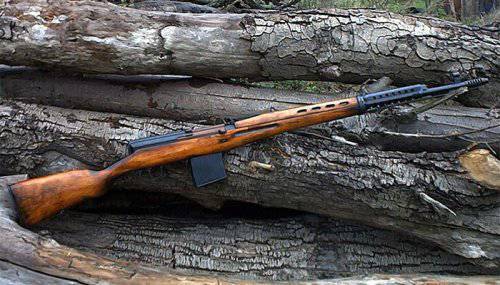
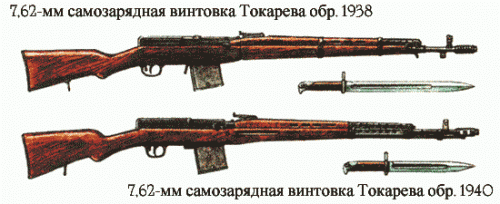
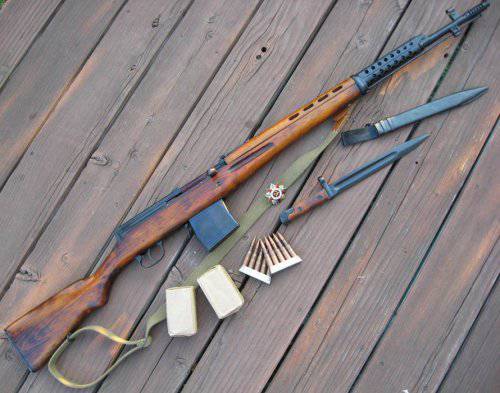
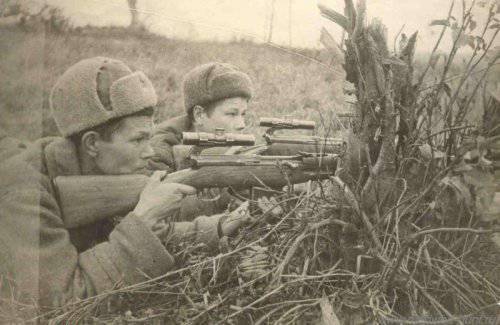
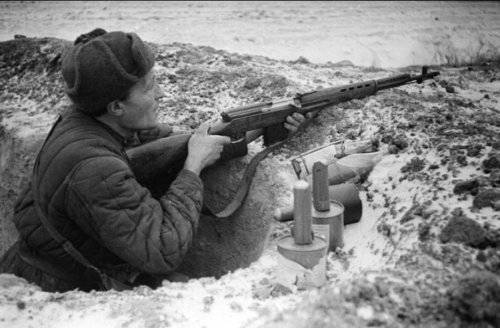

Information